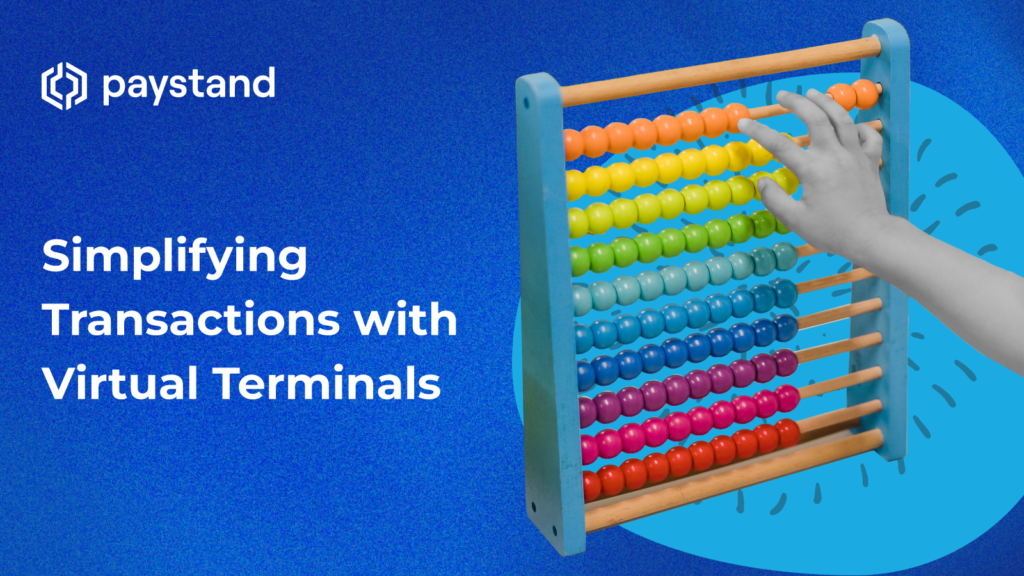
In the rapidly evolving world of digital payments, virtual terminals have gained significant prominence. Whether you’re a small business owner looking to accept credit card payments remotely or a customer making an online purchase, understanding virtual terminals is paramount. This article aims to demystify virtual terminals, providing you with a comprehensive overview of their functions, benefits, and how they can streamline your payment processes. By the end, you’ll have a clear understanding of virtual terminals and how they can transform your business transactions.

What is a virtual terminal?
Definition
A virtual terminal is a secure online platform that enables businesses to accept credit and debit card payments through a computer or mobile device. It functions as a virtual version of a traditional credit card terminal, providing businesses with a convenient and efficient way to process payments remotely.
How does it work?
Using a virtual terminal involves a few simple steps. First, the merchant logs into the virtual terminal software on their computer or mobile device. Then, they enter the customer’s payment information manually or through a card reader, if available. The information is securely transmitted through the internet to a payment processor, which verifies the customer’s payment details. Once the transaction is authorized, the funds are transferred from the customer’s account to the merchant’s account.
Benefits of using a virtual terminal
There are several advantages to using a virtual terminal for payment processing. Firstly, it offers flexibility and convenience by allowing businesses to accept payments from anywhere with an internet connection. This is particularly beneficial for businesses that operate remotely or have mobile sales teams. Secondly, virtual terminals provide a secure payment environment, ensuring that customer data is protected throughout the transaction process. Additionally, virtual terminals often come with features such as recurring payments and electronic invoicing, which can streamline payment processes and improve cash flow management for businesses.
Setting up a virtual terminal
Choosing a provider
When setting up a virtual terminal, it is important to choose a reliable payment service provider that meets your business needs. Consider factors such as pricing, customer support, and the provider’s reputation for security and reliability. Research different providers and compare their offerings to make an informed decision.
Required hardware and software
Setting up a virtual terminal typically requires a computer or mobile device with an internet connection. Merchants may also need to invest in additional hardware, such as a card reader, if they wish to process payments in-person. Additionally, virtual terminal software will need to be installed on the device used for payment processing. This software may be provided by the payment service provider or available for download from their website.
Integration with existing systems
Before setting up a virtual terminal, consider how it will integrate with your existing business systems. Ensure that the virtual terminal software can seamlessly integrate with your accounting software, customer relationship management (CRM) system, and other relevant tools. Integration can streamline business processes and allow for better data synchronization and reporting.
Virtual terminal vs. traditional credit card terminal
Differences in functionality
While traditional credit card terminals are physical devices that require a direct connection to a phone line or internet, virtual terminals are software-based and operate through a computer or mobile device connected to the internet. Traditional terminals are typically limited to processing payments only, while virtual terminals offer additional features such as invoicing, payment scheduling, and reporting capabilities.
Cost comparison
The cost of using a virtual terminal compared to a traditional credit card terminal varies depending on the provider and the business’s specific needs. Generally, virtual terminals have lower upfront costs since they do not require the purchase of hardware. Instead, merchants pay a monthly fee and transaction fees based on the volume of transactions processed. Traditional terminals may have higher upfront costs, including the purchase or lease of the terminal itself, as well as ongoing maintenance fees.
Security considerations
Virtual terminals and traditional credit card terminals differ in terms of security considerations. Virtual terminals have built-in security measures such as encryption and data protection protocols to safeguard customer data during transactions. Traditional terminals also have security measures, but they may be less robust and susceptible to physical tampering or data breaches. However, it is important for businesses to ensure that their chosen virtual terminal provider complies with Payment Card Industry Data Security Standard (PCI-DSS) requirements to ensure maximum security.
Using a virtual terminal for payment processing
Accepting credit and debit card payments
One of the primary functions of a virtual terminal is to accept credit and debit card payments. Once a customer provides their payment details, the merchant can enter the information into the virtual terminal manually or use a card reader to capture the information electronically. The virtual terminal securely transmits the payment details to the payment processor for authorization. If the transaction is approved, the funds are transferred to the merchant’s account.
Processing refunds and chargebacks
Virtual terminals also allow businesses to process refunds and manage chargebacks. If a customer requests a refund, the merchant can initiate the refund process through the virtual terminal software, which will then process the refund and update the transaction records accordingly. In case of a chargeback dispute, the merchant can provide the necessary evidence and documentation within the virtual terminal’s chargeback management system to support their case.
Managing recurring payments
Virtual terminals offer the convenience of managing recurring payments for businesses that have subscription-based or recurring billing models. Merchants can set up recurring payment schedules within the virtual terminal, allowing for automatic and predictable payment processing. This feature reduces manual intervention and improves cash flow management for businesses.

Security and compliance
PCI-DSS compliance
Payment Card Industry Data Security Standard (PCI-DSS) compliance is crucial for businesses that handle payment card data. When selecting a virtual terminal provider, it is essential to ensure that they comply with PCI-DSS requirements. PCI-DSS sets standards for data encryption, network security, and regular security audits to protect sensitive customer information.
Encryption and data protection measures
Virtual terminals employ encryption and data protection measures to safeguard sensitive customer information during payment transactions. This includes encrypting the payment data during transmission and securely storing customer data according to established security protocols. These measures ensure that customer data remains protected throughout the payment process.
Fraud prevention tools
Virtual terminals often come equipped with fraud prevention tools to detect and prevent fraudulent activities. These tools use algorithms and data analytics to identify potentially fraudulent transactions based on patterns, anomalies, or suspicious behavior. By mitigating the risk of fraud, virtual terminals offer businesses a secure environment for payment processing.
Reporting and analytics
Generating sales reports
Virtual terminals provide businesses with the ability to generate sales reports, giving them valuable insights into their transaction history. Merchants can access detailed reports on sales volume, transaction values, payment methods used, and more. These reports aid in financial analysis, inventory management, and decision-making processes.
Tracking transaction history
A virtual terminal keeps a comprehensive record of all transactions processed. This transaction history allows merchants to review individual transactions, track payment statuses, and reconcile their accounts. Tracking transaction history is crucial for accurate financial reporting, dispute resolution, and audit purposes.
Analyzing customer purchase behavior
Virtual terminals offer businesses the opportunity to analyze customer purchase behavior by capturing and storing data on individual transactions. By analyzing this data, merchants can gain insights into customer preferences, buying patterns, and trends. This information can then be used to optimize marketing strategies, tailor promotions, and enhance customer experiences.

Integrations with other tools
Integration with accounting software
Integrating a virtual terminal with accounting software can streamline business operations by automating financial processes. This integration enables seamless synchronization of transaction data, reducing the need for manual data entry. By eliminating manual tasks, businesses can improve accuracy, save time, and enhance financial reporting capabilities.
CRM and customer management integration
Integrating a virtual terminal with a Customer Relationship Management (CRM) system allows businesses to centralize customer data and streamline customer management processes. By syncing transaction data with the CRM system, businesses can track customer interactions, preferences, and purchasing history. This integration enables businesses to provide personalized experiences, targeted marketing campaigns, and efficient customer support.
Inventory management and tracking integration
Integrating a virtual terminal with inventory management and tracking systems can help businesses optimize inventory levels and streamline supply chain operations. When a customer makes a purchase through the virtual terminal, the inventory management system is automatically updated, ensuring accurate stock levels. This integration enhances inventory control, minimizes stockouts, and facilitates efficient order fulfillment.
Choosing the right virtual terminal provider
Considerations for small businesses
When selecting a virtual terminal provider, small businesses should consider factors such as pricing, transaction fees, and the scalability of the solution. It is important to choose a provider that offers a pricing structure suitable for the business’s transaction volume and growth projections. Additionally, small businesses should evaluate the provider’s customer support options and service level agreements to ensure prompt assistance in case of issues or downtime.
Scalability for growing businesses
For growing businesses, scalability is a crucial consideration when choosing a virtual terminal provider. The chosen provider should offer the flexibility to accommodate increased transaction volumes and additional features as the business expands. It is important to assess the provider’s track record in handling growing businesses and their ability to support evolving needs.
Customer support and service level agreements
Customer support is an essential aspect of a virtual terminal provider’s offering. It is important to choose a provider that provides reliable and responsive customer support, especially in times of technical issues or emergencies. Additionally, reviewing the provider’s service level agreements (SLAs) can help ensure that they meet the business’s requirements for uptime, response times, and issue resolution.

Common challenges and troubleshooting
Connection issues and downtime
Like any online platform, virtual terminals may experience connection issues or downtime, which can disrupt payment processing and business operations. In such cases, it is crucial to have a backup plan or alternative forms of payment acceptance, such as mobile payment solutions, to minimize the impact on business activities. Regularly testing the virtual terminal and monitoring internet connectivity can help identify and address potential issues proactively.
Payment gateway errors
Payment gateway errors can occur during the payment authorization process, causing transactions to be declined or delayed. Troubleshooting payment gateway errors often involves reviewing error codes, contacting the virtual terminal provider’s support team, and confirming the accuracy of the payment details entered. Familiarizing yourself with common error messages and resolving them promptly can minimize disruptions to payment processing.
Compatibility problems with different browsers or devices
Virtual terminals may encounter compatibility issues when used with different browsers or devices. It is important to ensure that the virtual terminal software is compatible with the browsers and devices used by your customers. Regular updates and compatibility tests can help address any compatibility issues, ensuring a seamless payment experience for customers.
Future trends and advancements
Mobile virtual terminals
Mobile virtual terminals are becoming increasingly popular due to the rise of mobile commerce and remote payment acceptance. Mobile virtual terminals allow businesses to process payments using smartphones or tablets, providing flexibility and convenience. This trend is likely to continue as businesses embrace mobile technology and customers seek more convenient payment options.
Artificial intelligence in virtual terminals
Artificial intelligence (AI) has the potential to revolutionize virtual terminals by enhancing fraud detection, improving customer experiences, and enabling personalized marketing strategies. AI can analyze vast amounts of transaction data, detect patterns, and identify anomalies that may indicate fraudulent activity. In addition, AI-powered virtual terminals can offer personalized payment experiences tailored to each customer’s preferences.
Biometric authentication for secure transactions
Biometric authentication, such as fingerprint or facial recognition, is gaining traction as a secure and convenient method for authorizing transactions. Virtual terminals can leverage biometric authentication to enhance security and streamline the payment process. By eliminating the need for passwords or PINs, biometric authentication offers a more user-friendly and robust method of verifying customer identities.
In conclusion, virtual terminals provide businesses with a secure and efficient means of accepting credit and debit card payments. They offer numerous benefits, including flexibility, enhanced security measures, and additional features such as recurring payment management. When setting up a virtual terminal, businesses need to choose a reliable provider, ensure compatibility with existing systems, and prioritize security and compliance. By leveraging the reporting and analytics capabilities of virtual terminals and integrating them with other tools, businesses can optimize operations and gain valuable insights into customer behavior. Choosing the right virtual terminal provider involves considering factors such as scalability, customer support, and service level agreements. Businesses should also be prepared to address common challenges and stay updated with future trends, including mobile virtual terminals, artificial intelligence, and biometric authentication. With a comprehensive understanding of virtual terminals, businesses can navigate the world of online payment processing with confidence.


